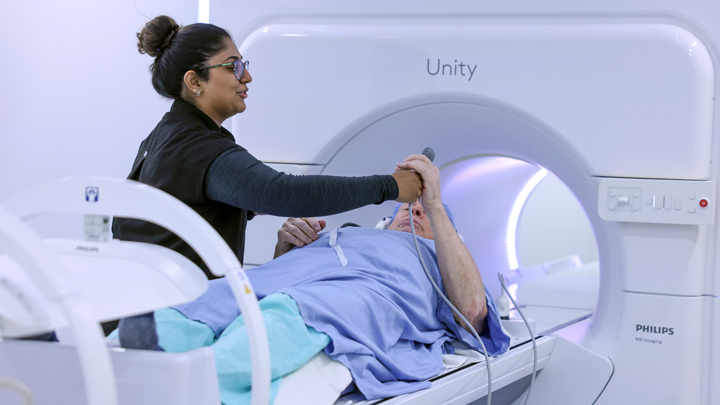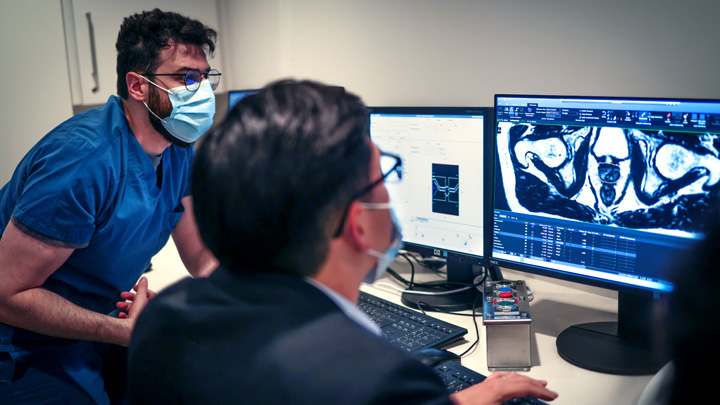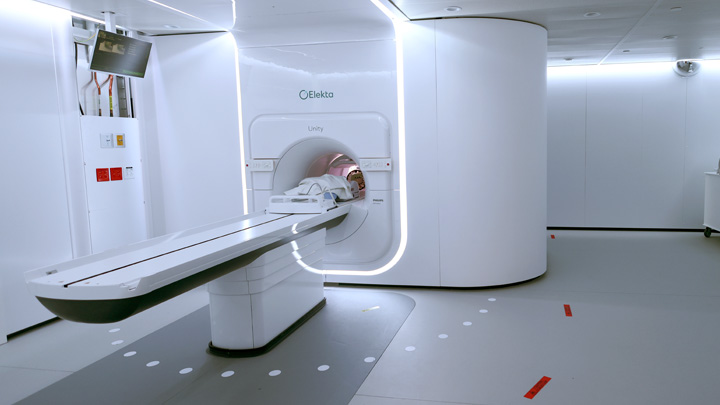
May 5, 2025

The first patient, Barry Flavelle, is treated on the MR-Linac at the Arthur Child Comprehensive Cancer Centre in Calgary. Photo by Leah Hennel.

The care team scans the detailed images during a training session on the MR-Linac. Photo by Leah Hennel.

The MR-Linac system combines real-time magnetic resonance imaging (MRI) with radiation delivery. Photo by Leah Hennel.
Story by Jennifer Green | Photos by Leah Hennel
CALGARY — Cancer treatment in Alberta marked a significant advance in radiation oncology when the Arthur Child Comprehensive Cancer Centre treated its first patient using MR-Linac technology.
The MR-Linac system integrates real-time magnetic resonance imaging (MRI) with radiation delivery. This allows for continuous visualization of the tumour and surrounding healthy tissue during treatment — and enables radiation oncologists to precisely target mobile tumours or those located near critical organs. The anticipated clinical benefits include improved tumour control and a reduction in treatment-related side effects.
“This is a really good option, less side effects, less visits, same amount of radiation in total apparently — but just administered a little quicker,” says the first patient, Barry Flavelle, who received treatment on April 8. “I don’t like hospitals in the first place, so I don’t want to come up 25 times to a hospital if I can do it in five.”
Funding for a significant portion of the two MR-Linac machines was secured through the Alberta Cancer Foundation’s OWN.CANCER campaign, a $250-million fundraising initiative aimed at enhancing cancer care and research at the Arthur Child facility.
“In total, the equipment was $80M and the donor community came up with three quarters of that,” says Wendy Beauchesne, CEO of the Alberta Cancer Foundation. “What that shows you is how much the community wants to get behind the cause. How much the community wants to help those facing cancer and making sure we have access to the very best right here at the Arthur Child.”
The MR-Linac delivers high-dose radiation treatments that are adapted daily based on individual patient anatomy and disease characteristics.
The initial phase of clinical use focused on prostate cancer, with an anticipated treatment capacity of three to four patients per day.
Each treatment session lasts between 45 and 60 minutes, potentially allowing for eight to 10 patients to be treated daily as the program matures.
“Any of our cancer patients have the ability to benefit from this,” says Fiona Lochray, manager of Radiation Therapy at the Arthur Child. “The idea behind it is that we’ll be able to do higher doses of radiation in order to kill off the tumour cells in a shorter period of time.”
Future clinical applications of the MR-Linac at the Arthur Child are planned for other tumour sites requiring this level of precision, including central nervous system tumours, pancreatic cancer, and spinal metastasis.
The timelines for these expansions are under evaluation to ensure optimal utilization of the technology for patients who will most benefit. Program expansion is expected to occur in conjunction with the development of clinical expertise and streamlined workflows.
Barry adds: “Enabling a building like this to be built — full of equipment and top-notch doctors — you have nothing but thanks to those individuals who donated.”